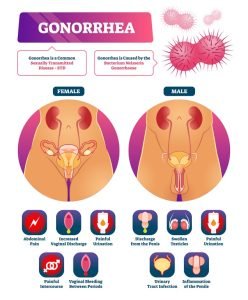In this article, Juliet Jacob Ochenje writes on the rising scourge of sexually transmitted diseases in Nigeria, especially among youths, and how it could disrupt the lives of the patients and society at large.
‘’I started noticing symptoms of pain while urinating; severe pain under my groins. The pain became severe, and out of fear, I rushed to my mum and told her how I felt and she took me to the hospital. They ran a test and that’s when they realised I was infected with gonorrhea. That experience was a terrible one for me.’’
Above is the experience of 37-year-old Mr. Victor Essien, a resident of Abuja, who spoke with African Health Report (AHR). Like him, many other Nigerians have had sexually transmitted diseases (STDs) in their life time, with gonorhea widely reported. On the whole, Sexually Transmitted Infections (STIs), used interchangeably with STDs in this report, remains a very important public health problem.
Gonorrhea is a sexually transmitted infection (STI), also known as a sexually transmitted disease (STD). Mayo Clinic explains that it is caused by a bacterium that infects both males and females. The disease most often affects the urethra, rectum or throat. In females, gonorrhea can also infect the cervix. In many cases, gonorrhea infection causes no symptoms. Symptoms, however, can affect many sites in your body, but commonly appear in the genital tract.
This STI is most commonly spread during vaginal, oral or anal sex. But babies of infected mothers can be infected during childbirth. In babies, gonorrhea most commonly affects the eyes.

The Federal Ministry of Health, in its Summary of the Syndromic Management of STIs and RTIs in Nigeria, indicated that 499 million new cases of curable STIs occur each year globally. These consist of 10.6 million cases of syphilis, 106.1 million cases of gonorrhea, 105.7 million cases of chlamydia and 276.4 million cases of trichomoniasis.
These figures do not include the additional health burden caused by HIV and other viral STIs such as Herpes Simplex Virus Infections.
Ignorance, Youthful Exuberance and STIs
”Back in my secondary school days, I knew nothing about sex and I wasn’t given orientation on sex education by my parents because they felt or thought sex education was mainly for the girl child,” Victor Essien continued in his interview with AHR.
”Out of ignorance, I had sexual intercourse with a female student back in secondary school, and after a week interval, I started noticing symptoms of pain while urinating.”
”My candid advice to youths out there is safe and protected sex should be paramount with a condom or stick to one partner to avoid being infected. And also, sex education should not only be for the girl child.”
A retrospective study carried out in the University College Hospital (UCH) Ibadan, Nigeria, where records of a total of 506 patients who attended the clinic between January 2010-December 2011 were retrieved, cited recent surveys which reported gonorrhea prevalence to be as high as 28.1% [8].
”In the present study, most of the STI cases occurred in the 21-30 yr age group….This age group is the sexually active group and at a high risk of being behaviorally more vulnerable to STI acquisition, as they generally have higher number of sexual partners and more concurrent partnerships and change partners more often than older age groups. Being the economically productive group, there is a great loss of manpower at work due to STI morbidity. This is also the predominant age group observed to be having STI cases in other Indian studies. Prevalence of STI is as follows in this study gonorrhea 3(0.6%), candida 55(10.9%) and syphilis 2(0.4%).”
Implication on Public Health
The Ministry of Health notes that the public health importance of STIs/RTIs is indisputable because they are associated with significant socio-economic consequences. These include cost of treatment and absenteeism from work, social stigmatisation of patients of STIs/STDs and psychological consequences and infertility arising from complications. Untreated STIs/RTIs can lead to loss of employment and broken marriages, leading to disruption of the family unit, the Ministry added.
Toilet Infections: Fact or Fiction?
Miss Blessing Jonah is a young lady who works as a waitress in a ”very big and well known place in Abuja.” She agreed to share her story with AHR but requested that her picture should not be attached to this report.

”If I’m not mistaken, we usually have more than a hundred guests mostly on weekends and we all share the same toilets. For the fact that the toilets are always clean, I sit on them comfortably. So, as at last week, I started feeling itching in my private parts and and it was extremely terrible, I mean it is not something you will wish for an enemy because I was so uncomfortable. I had this bacteria without even knowing until it became so severe. I went to the hospital, conducted a medical test and the doctor said I had an infection. I was given medications and injections to flush it out of my system. This happened because I didn’t pay close attention to my body system.
”Women should always pay attention to their body whenever they discover some foul smell within their private parts, go to the hospital for checkup or if you start having some yellowish discharge, consult a doctor or a nurse,” she advised.
Just like her, there are many people who believe that ‘toilet infections’ exist but medically, there is no such thing. According to ‘Man and Microbes’, the term is a popularly used for describing infections gotten after using the toilet. It describes the signs and symptoms of vulvovaginitis: burning sensation, foul-smelling discharges, and burning sensation.
Therefore, the true word for toilet infection is vulvovaginitis or vaginal infection. It further explained that toilets, toilet seats, toilet bowls, and toilet paper itself cannot cause infections, microorganisms do —microorganisms such as bacteria, viruses, and fungi.
There are two ways to refer to vulvovaginitis: vaginitis, when only the vagina is affected, and vulvitis when only the vulva is affected, it continued, and other infections that could be contracted via the toilet, which are also referred to as urinary tract infections (UTIs) or vaginal infections, are prevalent medical conditions that can plague both men and women.
Such infections are known to occur due to several factors which include unsanitary practices, higher levels of bacteria or fungi as stated earlier, and sexual intercourse.
Prevention as Best Treatment For STDs
For Dr. Philip I.P. Nwajiobi-Princewill, a Senior Consultant Medical Microbiologist, Departmwnt of Microbiology, National Hospital, Abuja, the best way to prevent STDs is to compketely abstain from having sex. He noted that STIs are infections that are passed from one person to another through sexual contact, especially unprotected sexual contact during vaginal, oral or anal sex, or during pregnancy and delivery.

He said most of the common STIs in Nigeria are chlamydia, gonorrhoea, syphilis, Hepatitis B, Herpes and HIV. They are caused by infection by microorganisms, i.e. too small for the unaided, aka naked eye, to see. Examples of this bacteria are gonorrhea, syphilis and chlamydia, parasites (trichomoniasis), viruses (HBV, Herpes simplex virus and HIV).
He further said the ways of preventing STDs includes the use condoms and dental dams consistently and correctly; staying with one uninfected sex partner; vaccination-Know your status-Get tested and male circumcision.
Improper Treatment of STDs/STIs Could Lead to Cancer, Infertility, Others
Dr. Nwajiobi-Princewill also noted that the high prevalence of self medication and across the counter dispensing of antibiotics by both unlicensed agents and licensed agents without prescription when such infections are presented to them results in misuse of antibiotics leading to resistance, ineffective and inappropriate regimens and side effects if not treated properly.
These effects include chronic pelvic pain, infertility, cancer, pregnancy complications, joint infection (arthritis), pelvic inflammatory disease, heart disease, eye infection, congenital infections and complications.
When asked what age group are more vulnerable to this infection, Dr. Philip said sexually active age group, especially females and those between the ages of 15 and 24. He also listed some lifestyle choices that puts one at risk of these diseases as having unprotected sex – Vaginal or anal penetration by an infected partner who isn’t wearing a latex condom significantly increases the risk of getting an STI.
Use of alcohol or illicit drug use – Having sex while under the influence of drugs or alcohol can lower inhibitions and result in greater sexual risk-taking; multiple sex partners, especially having sequential sex partnerships of limited duration or concurrent partnerships and involvement in the sex trade or practicing sex in exchange for food, shelter or money.


